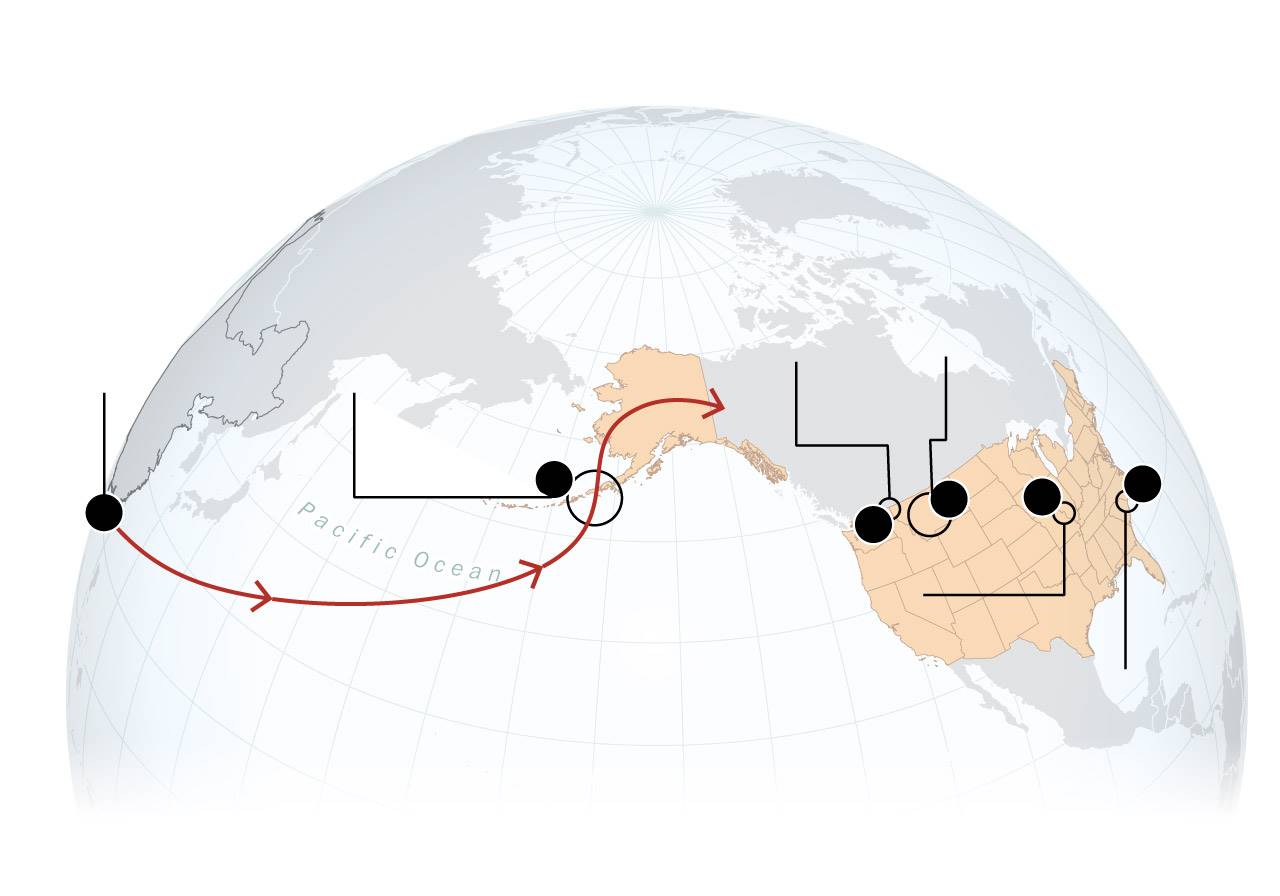The U.S. tracked a China spy balloon from launch on Hainan Island along an unusual path

The large Chinese surveillance device that flew across Alaska and the continental United States may have been diverted on an errant path caused by atypical weather conditions
By the time a Chinese spy balloon crossed into American airspace late last month, U.S. military and intelligence agencies had been tracking it for nearly a week, watching as it lifted off from its home base on Hainan Island near China’s south coast.
U.S. monitors watched as the balloon settled into a flight path that would appear to have taken it over the U.S. territory of Guam. But somewhere along that easterly route, the craft took an unexpected northern turn, according to several U.S. officials, who said that analysts are now examining the possibility that China didn’t intend to penetrate the American heartland with its airborne surveillance device, The Washington Post reported.
The balloon floated over Alaska’s Aleutian Islands thousands of miles away from Guam, then drifted over Canada, where it encountered strong winds that appear to have pushed the balloon south into the continental United States, the officials said, speaking on the condition of anonymity to describe sensitive intelligence. A U.S. fighter jet shot the balloon down off the coast of South Carolina on Feb. 4, a week after it crossed over Alaska.
Watch the U.S. shoot down a Chinese balloon
A U.S. military aircraft on Feb. 4 downed the suspected Chinese surveillance balloon that had been floating over the United States for several days. (Video: Brett Adair)
On the U.S. military aircraft on Feb. 4 downed the suspected Chinese surveillance balloon that had been floating over the United States for several days. (Video: Brett Adair)
This new account suggests that the ensuing international crisis that has ratcheted up tensions between Washington and Beijing may have been at least partly the result of a mistake.
Meanwhile, the White House on Tuesday said that three other objects shot down over North America in the last week may have posed no national security threat, striking perhaps the clearest distinction yet between those flying anomalies and the suspected spy balloon. John Kirby, the National Security Council’s coordinator for strategic communications, told reporters that the U.S. intelligence community “will not dismiss as a possibility” that the three craft instead belonged to a commercial organization or research entity and were therefore “benign.”
The People’s Liberation Army (PLA) has sent spy balloons over Guam before, as well as Hawaii, to monitor U.S. military installations, officials have said. But the days-long flyover of the continental United States was novel, and it sparked confusion inside the Chinese government as diplomats scrambled to disseminate a cover story that the balloon had been blown off course while it was collecting innocuous meteorological data, U.S. officials said.
The furor caught Beijing on its back foot. Initially, it expressed “regrets” over what it insisted was a wayward weather balloon. Then it shifted to criticizing Washington for what it said was overreacting, and this week it accused the United States of sending 10 spy balloons over China. The White House has strongly denied the claim as false. “We are not flying surveillance balloons over China. I’m not aware of any other craft that we’re flying over — into Chinese airspace,” Kirby said Monday.
The U.S. intelligence and military agencies tracked the balloon as it launched from Hainan Island. Intelligence analysts are unsure whether the apparent deviation was intentional or accidental but are confident it was intended for surveillance, most likely over U.S. military installations in the Pacific. Either way, the incursion into U.S. airspace was a major misstep by the PLA, prompting a political and diplomatic furor and deeper scrutiny by the United States and its allies of Beijing’s aerial espionage capabilities.
It is crossing into U.S. airspace was a violation of sovereignty and its hovering over sensitive nuclear sites in Montana was no accident, officials said, raising the possibility that even if the balloon were inadvertently blown over the U.S. mainland, Beijing apparently decided to seize the opportunity to try to gather intelligence.
The balloon’s journey
U.S. agencies tracked the balloon as it launched from Hainan Island, China.
Seen above Montana, over Minuteman III launch facilities.
The U.S. military downed the balloon over the Atlantic Ocean near the coast of the Carolinas.

The incident was just the latest indication of how purposefully China is going about expanding its surveillance capabilities — from advanced satellite technology to balloons, officials said.
The balloon fleet is part of a much broader air surveillance effort that includes sophisticated satellite systems and into which the Chinese government has poured what analysts say are billions of dollars of investment over the years.
“This was a discrete program — part of a larger set of programs that are about gaining greater clarity about military facilities in the United States and in a variety of other countries,” said one senior U.S. official. It appears to be meant to “augment the satellite systems.”
The balloon was launched from the ground, part of a program run in part by the PLA air force, and it may have been taken off course by strong high-altitude winds, officials said. It was partly directed by air currents and partly piloted remotely, they said. With propellers and a rudder, it has the capability to be maneuvered.
After the balloon launched, computer modeling conducted by The Washington Post indicates steering currents would have pushed it due east over the Pacific Ocean, probably passing between the Philippines and Taiwan.

Around Jan. 24, when the balloon would have been roughly about 1,000 miles south of Japan, model simulations show it began to gain speed and rapidly veer north. This would have been in response to a strong cold front that had unleashed exceptionally frigid air over northern China, the Korean Peninsula, and Japan.
Ordinarily, atmospheric steering motions would have kept the balloon on much more of a west-to-east course, historical weather data shows. However, the intense cold front forced the jet stream and high-altitude steering currents to dip south and may have scooped the balloon northward.

The airship entered U.S. airspace off Alaska on Jan. 28, crossing Canada and reentering the United States over Idaho on Jan. 31, one day before it was spotted over Montana by civilians, prompting a ground stoppage at the airport in Billings, as U.S. officials considered shooting it down.
When officials determined they could not mitigate the risk to people on the ground, they decided to wait until they could shoot it down over the water.
Analysts are still awaiting the retrieval of the balloon’s payload, which officials estimated to be the size of three school buses, but “it doesn’t look like it’s a dramatic new capability,” said a second U.S. official. “It looks like it’s more collection — everybody always wants more.”
Kirby said Monday: “These balloons have provided limited additive capabilities to the [People’s Republic of China’s] other intelligence platforms used over the United States. But in the future, if the PRC continues to advance this technology, it certainly could become more valuable to them.”
U.S. officials stressed that they took steps to defeat any efforts by China to gather sensitive information from military sites. Any such information or communications were encrypted, Kirby has said.
“The name of the game of spying is always new capability, new mitigation,” said the second official.
Napomena o autorskim pravima: Dozvoljeno preuzimanje sadržaja isključivo uz navođenje linka prema stranici našeg portala sa koje je sadržaj preuzet. Stavovi izraženi u ovom tekstu autorovi su i ne odražavaju nužno uredničku politiku The Balkantimes Press.
Copyright Notice: It is allowed to download the content only by providing a link to the page of our portal from which the content was downloaded. The views expressed in this text are those of the authors and do not necessarily reflect the editorial policies of The Balkantimes Press.

